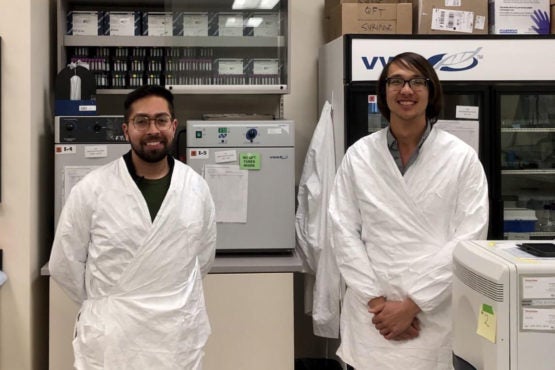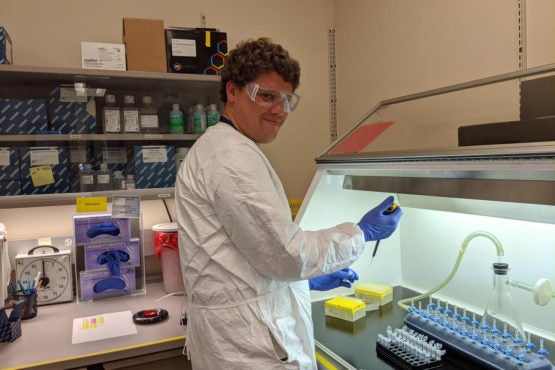Stanford students help overwhelmed lab in Monterey County with COVID-19 testing
After learning that the county’s Public Health Lab was short-staffed and struggling to meet demand for testing, Stanford graduate student Paul Bump rallied his fellow researchers to volunteer their time.
A small lab providing COVID-19 testing to residents in two nearby counties is getting some much-needed support from Stanford students.

Stanford PhD students Jose Miguel Andrade Lopez, left, and Paul Bump in the Monterey County Public Health Lab. (Image credit: Courtesy Paul Bump)
In March, the Monterey County Public Health Lab was struggling to meet demand for COVID-19 testing. Working around the clock to process tests, the lab’s small staff quickly became overwhelmed. When Stanford grad student Paul Bump learned that the staff was on the verge of burnout, he immediately reached out to the lab’s director.
“I had already become familiar with testing protocols and had done some similar things before, like extracting RNA,” Bump said. “So I thought I could help.”
Bump is a fourth-year doctoral student studying developmental biology. He’s primarily based at Stanford’s Hopkins Marine Station in Pacific Grove, where his research is focused on marine animals. Although his research isn’t directly related to the work the lab is doing, he knew he had the ability to assist them.
“I don’t work on viruses or human-related things, but the process of careful molecular research is something I’ve done as an undergrad and graduate student,” Bump said.
Rallying researchers
The Monterey County Public Health Lab employs three microbiologists to provide testing services for roughly 500,000 residents in both Monterey and San Benito counties. It is the only lab in the region performing testing for the new coronavirus. Donna Ferguson, the lab’s director, said that before the volunteers arrived, her team had identified two positive cases and knew that demand for testing would increase.

Stanford postdoctoral scholar Brendan Cornwell volunteering at the Monterey County Public Health Lab. (Image credit: Dr. Donna Ferguson)
“I was very concerned that with limited staff, we would not be able to produce test results within 24 hours of specimen receipt, which is crucial for making medical decisions about patient care and for contact tracing to manage further spread of COVID-19,” Ferguson said. “I was also concerned about staff falling ill to COVID-19, which would lead to testing delays.”
Soon, the lab’s small team was working nine to 10 hours a day without days off and Ferguson began to worry about burnout.
When Bump read a local news article about the lab’s struggles, he contacted Ferguson. “I sort of just said, ‘Here are my skills and background. Would this be helpful?’” Bump said.
The testing process is one that Bump said is very “hands-on” and requires a lot of people and time. So he sent an email to his fellow researchers at Hopkins to solicit their help. Word spread to neighboring institutions California State University, Monterey Bay and the University of California, Santa Cruz. Soon, a small team of researchers – including Bump, Stanford PhD student Jose Miguel Andrade Lopez and Stanford postdoc Brendan Cornwell – was volunteering in the lab.
Since mid-March, the volunteers have been rotating shifts in the lab, where they help process COVID-19 tests. Their work includes disinfecting work areas prior to testing, preparing specimen collection kits, receiving and unpackaging patient specimens and recording patient information into the lab’s database. They also perform nucleic acid extraction methods, assist with loading specimens into thermocyclers and archive tested specimens, among other tasks. Although Bump had to undergo a bit of training, he said the work isn’t too different from his research with marine life.
“The only difference is that we’re dealing with patient samples rather than animal samples,” he said.
Bump and the other volunteers are currently working about 20 to 30 hours a week in the lab while also keeping up with their schoolwork and research.
Increased testing capacity
Since Bump, Lopez, Cornwell and the other researchers began volunteering their services, the Monterey County Public Health Lab has seen a surge in productivity. Ferguson said that when the volunteers arrived, the lab increased testing from about 20 specimens a day to 40. Since the volunteers have become more experienced in the testing process and developed a workflow, the lab is now testing an average of 100 to 120 specimens a day.
“On one day we performed 150 tests, which is our record,” Ferguson said.
What’s more, the volunteers have reduced the workload for the regular staff, enabling them to avoid burnout.
In her years as a research scientist, Ferguson said she has had the opportunity to work with graduate students and postdocs from universities all over the world, and is struck by the efforts of those from Stanford.
“Stanford’s students continue to impress me as among the most dedicated and hardworking that I’ve had the pleasure of working with,” she said.
Bump said that although his research focuses on marine biology, he’s happy he was able to contribute to the lab’s work and is grateful for the collective efforts of other researchers at Stanford’s Hopkins Marine Station and other institutions.
“When you think about the [Hopkins] Marine Station, you don’t think about molecular biologists,” Bump said. “But there’s a huge variety of scientists here with a unique mix of skill sets and it’s interesting that they can come together to address this crisis.”
